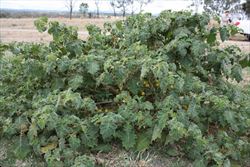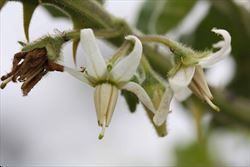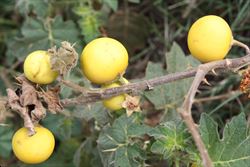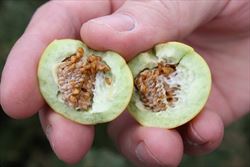Click on images to enlarge

habit (photo: Biosecurity Queensland)

flower (photo: Biosecurity Queensland)

fruit and spines (photo: Biosecurity Queensland)

seeds (photo: Biosecurity Queensland)
Scientific Name
Solanum viarum Dunal
Synonyms
Solanum chloranthum DC.; Solanum khasianum var. chatterjeeanum Sen Gupta; Solanum viridiflorum Schltdl.
Family
Solanaceae
Common Names
tropical soda apple
Origin
South America
Naturalised Distribution
Naturalised in north-eastern NSW and south-east Queensland (Coominya, Willowbank and Warwick), mainly in disturbed areas.
Habitat
Disturbed areas and paddocks in a range of habitats.
Habit
An upright much-branched spreading prickly shrub, 0.5-2m high.
Distinguishing Features
- Upright much-branched perennial shrub 0.5-2m high.
- Leaves and stems are armed with prickles up to 12 mm long.
- These prickles have a wide base.
- Leaves are 10-20cm long and 6-15cm wide and covered with short hairs.
- Flowers are white with five recurved petals and cream-coloured stamens.
- Immature fruits are mottled light and dark green like a watermelon.
- Mature fruits are smooth, round, yellow, and 1-3cm in diameter with a leathery skin surrounding a pale green, scented pulp.
- Fruits contain 180 to 240 seeds.
Stems and Leaves
Leaves and stems are armed with prickles up to 12 mm long. The prickles have a wide base. Leaves are 10–20cm long and 6–15cm wide and covered with short hairs.
Flowers and Fruit
The flowers are white with five recurved petals and white to cream-coloured stamens.
Immature fruits are mottled light and dark green like a watermelon. Mature fruits are smooth, round, yellow, and 1-3cm in diameter with a leathery skin surrounding a pale green, scented pulp. Fruits contain 180 to 240 seeds.
Reproduction and Dispersal
This species reproduces by seed, which are mainly spread by cattle and other fruit-eating animals and birds.
Environmental Impact
Potential to invade native open forest
Other Impacts
Potentially invasive of pasture.
Legislation
This species is declared under legislation in the following states and territories:
- New South Wales: Class 2 - a regionally
prohibited weed. The presence of the weed must be notified to the local
control authority and it must be eradicated from the land and the land
must be kept free of the plant (on Lord Howe Island only), and Class
3 - a regionally controlled weed. The relevant local control
authority must be promptly notified of the presence of this weed and it must
be fully and continuously suppressed and destroyed (in a large number of local
authority areas). See the New South Wales Department of Primary
Industries Noxious Weeds List at http://www.dpi.nsw.gov.au for more
detailed information on which local areas are covered in these
declarations.
Management
- the Biosecurity Queensland Fact Sheet on this species, which is available online at http://www.daff.qld.gov.au.
- the New South Wales Department of Primary
Industries weed alert on this species, which is available online at
http://www.dpi.nsw.gov.au.
Similar Species
non-native species: Solanum torvum (Devil´s fig); Solanum chrysotrichum (Giant Devil´s fig); Solanum capsicoides (Devil´s apple); Solanum linnaeanum (Apple of Sodom)
native species: Solanum ditrichum A.R.Bean, which has prickles with a narrow base compared ot S. viarum which has prickles with a broad base. The distributions overlap.

